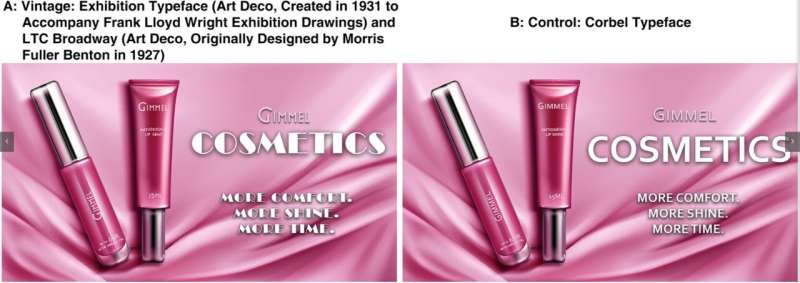This article has been reviewed according to Science X's editorial process and policies. Editors have highlighted the following attributes while ensuring the content's credibility:
fact-checked
trusted source
proofread
Power of nostalgia: Vintage typography can build emotional connections, influence attitudes, boost willingness to pay

Researchers from University of Newcastle–Australia have published a new Journal of Marketing study that examines how brands can use references to the past via vintage typography to establish emotional bonds with today's consumers.
The study is titled "Typography Talks: Influencing Vintage Anemoia and Product Safety Perceptions with Vintage Typography" and is authored by Alicia Kulczynski and Margurite Hook.
What connects the recent Barbie movie, the return of McDonald's Grimace, Pepsi's adoption of an '80s style logo, and Clairol's partnership with Amazon Prime's "Daisy Jones & The Six?" They all tap into the past, reminding us of simpler and happier times.
It is impossible to ignore the resurgence of nostalgia in brands and advertising. Nostalgia is all around us, from the products we use to the commercials we watch, and this trend is not limited to fast food giants or beauty products.
Chex Mix's remix of Sir Mix-A-Lot's "Baby Got Back" and Old Bay Goldfish's remake of Lisa Loeb's "Stay (I Missed You)" take us back to the '90s. Rakuten's 2023 "Clueless" Super Bowl teaser and Netflix's "Stranger Things" series are loaded with references to the past. Nostalgia is an emotion that consumers are embracing and that brands are ingeniously using to connect with their audience.
This new study explores the power of nostalgia and how brands can use references to the past to establish emotional bonds with today's consumers. It does not revolve around products or music, but focuses on vintage typography and the role it plays in establishing an emotional connection with consumers through nostalgia and, in turn, enhancing consumers' perceptions of product safety.
As Kulczynski explains, "although it may appear a minor aspect in marketing and advertising, typography extends beyond aesthetics. It plays a pivotal role in shaping how people think, feel, behave, evaluate brands, and make choices."
An emotional connection to the past
The researchers discovered that vintage typography can trigger what they call "vintage anemoia," a unique form of vicarious nostalgia. This describes a consumer's emotional connection to the past and appreciation for the aesthetics, fashion, styles, design, and cultural elements associated with vintage cues.
This connection is irrespective of a specific historical period or individual lived experiences. In other words, vintage typography can evoke a nostalgic response from consumers, regardless of their ability to draw from childhood memories or specific historical events. Vintage typography, through its reference to the past, evokes the feelings of the "good old days"—quality, beauty, and happiness associated with the past, whatever that past may be for the individual consumer.
People are yearning for a connection to a time when life was less complicated. In an era marked by uncertainty, from economic and political instability to public health challenges like the COVID-19 pandemic, people seek the simplicity and stability of the past. Nostalgia provides a sense of comfort, making people feel safe and secure. "Our research findings show that when consumers experience vintage anemoia after seeing vintage typography in an advertisement, brand logo, or packaging, they perceive the brand's product's to be safer," says Hook.
The research explores the effects of vintage typography and vintage anemoia on consumer product safety perceptions in seven studies. It reveals that consumers have a more positive attitude toward brands that incorporate vintage typography. They are more likely to purchase the brand's products and are willing to pay more for them due to the perception that the products are safer.
The power of implicit cues
However, the effectiveness of vintage typography is context-dependent. It does not work when the establishment year of a brand is shown because vintage anemoia relies on implicit cues to establish links to one's past. Vintage typography is also ineffective for inducing vintage anemoia when promoting futuristic products because this diverts consumer attention away from the past, weakening the nostalgic effect.
In summary, the research offers valuable lessons for marketers:
- Vintage typography has the potential to evoke nostalgia and enhance perceptions of safety.
- Brands looking to emphasize safety or address safety concerns associated with their products can benefit from vintage typography, which not only promotes nostalgia but also positively influences perceptions of product safety.
- Vintage typography is more than just aesthetics; it is a strategic tool for creating strong emotional connections with consumers and shaping consumer perceptions.
- Brands should thoughtfully consider their positioning, consumer associations, and product attributes before adopting vintage typography.
By aligning vintage aesthetics with their goals and avoiding potential pitfalls, marketers can harness the emotional power of nostalgia to create stronger emotional connections with consumers and enhance safety perceptions.
More information: Alicia Kulczynski et al, Typography Talks: Influencing Vintage Anemoia and Product Safety Perceptions with Vintage Typography, Journal of Marketing (2023). DOI: 10.1177/00222429231215357
Provided by American Marketing Association




















